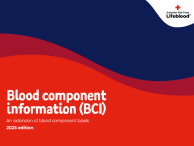Don’t have an account?
Select the donation type you’d like to make
Cryodepleted plasma contains most clotting factors in similar amounts to FFP but is deficient in factor VIII, fibrinogen, von Willebrand factor (the high molecular weight multimers are more thoroughly removed than the smaller multimers), factor XIII and fibronectin.
Cryodepleted plasma has a shelf life of 12 months when stored at –25˚ C or below.
Cryodepleted plasma may be used for plasma exchange in thrombotic thrombocytopenic purpura (TTP). It may also be used as an alternative to FFP for the treatment of coagulopathy where there is no significant reduction in factor VIII, fibrinogen, or factor XIII.
Large-dose apheresis cryodepleted plasma will not be manufactured after December 2024. It is being replaced (from January 2025) with split apheresis units, with three units produced from a single apheresis donation. This means laboratories may have a mixed inventory of large-dose and split apheresis cryodepleted plasma units until stocks of large-dose units are used or expire.
Typical unit content and specifications
The typical unit content data is derived from Lifeblood process control testing. For each parameter, the mean value (± 1 SD) and specification is shown.
Unless otherwise specified, data is for the period 1 January to 31 December 2024.
Cryodepleted plasma whole blood
| Volume (mL) | 246 ± 12 (215–265) |
Cryodepleted plasma apheresis
Large dose (Manufacture discontinued) | Split apheresis (From January 2025)* | |
|---|---|---|
| Volume (mL) | 757 ±10 (675–825) | 238 ± 4 (215-265) |
Note: * Split apheresis typical contents based on final validation data; one split apheresis unit is equivalent to one unit of whole blood cryodepleted plasma, and these are equivalent and can be used interchangeably.
Availability
Cryodepleted plasma is available in all ABO groups. Matching for RhD type is not required.
Modifications
There is no modification available for cryodepleted plasma. Matching for RhD type is not required.
Updated September 2025


